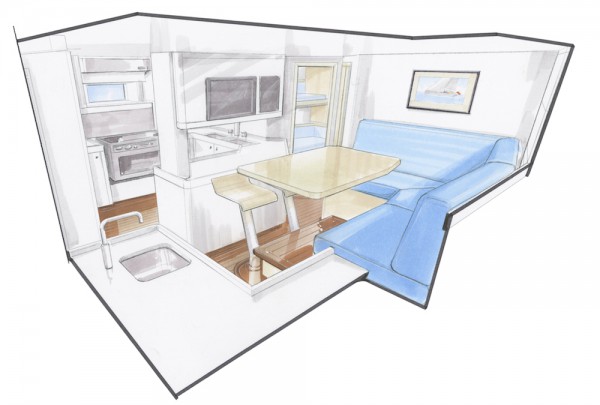Not-so-smooth sailing under LY3
The MLC and LY3 are all about more space for crew, so how are sailing yachts, where space is notoriously harder to come by, coping?
Since the ratification of the Maritime Labour Convention, 2006 (MLC) in August 2013, superyacht designers and builders have had two and a half years to come to terms with crew accommodation requirements of the Large Yacht Code 3 (LY3), which offer yacht-specific equivalences to the MLC.
In short, LY3 demands more space for crew and per crewmember. On production motoryachts this has been easy enough to implement. Sunseeker has in fact claimed that the building requirements have made the shipyard’s life easier.
Sailing yachts, however, aboard which space is harder to come by, have struggled somewhat. Not struggled to comply, but struggled in the context of their previous models.
Oyster Yachts, for example, has made significant amendments to its Oyster 100, turning it into the Oyster 885, to ensure the sailing yacht falls just an inch or so short of the cut-off point of the LY3’s 24m load line, above which the regulations must apply. “The code has made it very difficult to produce an economic, commercially coded boat with the right sort of mixture of space between 90 and 100ft, so responding to the LY3 code, we’ve decided to have two boats just below the 24m load line and one above it [the 118], and we’re unlikely to do one in between,” explains David Tydeman, Oyster Yachts CEO.
The Oyster 118 crew mess
It all started with the Oyster 100, built to LY2, which resulted in the above decision. The five-cabin boat received special dispensation to run as a four-crew boat rather than the six crew the code would imply. Why? In the words of Tydeman, “With sailing yachts, if you fully comply with the code as you would need to for a commercial boat, you end up wit not enough space for the owners and guests”. So the only option was to design the next model, the Oyster 885, below that 24m line and therefore allowing six cabins for four crew, owners and guests. “There’s an irony there,” admits Tydeman. “That the owner of a smaller boat had more space for himself and his guests, because we were building below the code.”
Admittedly, on the larger sailing yachts where there is more space overall, the MLC and LY3 are less likely to have an impact on design. But when it becomes known that a shipyard has created a model specifically to avoid having to comply with the regulations, it does raise the question of the effects this red tape is having on this industry.
Read more about the effects of the MLC and LY3 on production and semi-production superyacht builders in issue 167 of The Superyacht Report.
Profile links
NEW: Sign up for SuperyachtNewsweek!
Get the latest weekly news, in-depth reports, intelligence, and strategic insights, delivered directly from The Superyacht Group's editors and market analysts.
Stay at the forefront of the superyacht industry with SuperyachtNewsweek
Click here to become part of The Superyacht Group community, and join us in our mission to make this industry accessible to all, and prosperous for the long-term. We are offering access to the superyacht industry’s most comprehensive and longstanding archive of business-critical information, as well as a comprehensive, real-time superyacht fleet database, for just £10 per month, because we are One Industry with One Mission. Sign up here.
NEW: Sign up for
SuperyachtNewsweek!
Get the latest weekly news, in-depth reports, intelligence, and strategic insights, delivered directly from The Superyacht Group's editors and market analysts.
Stay at the forefront of the superyacht industry with SuperyachtNewsweek




